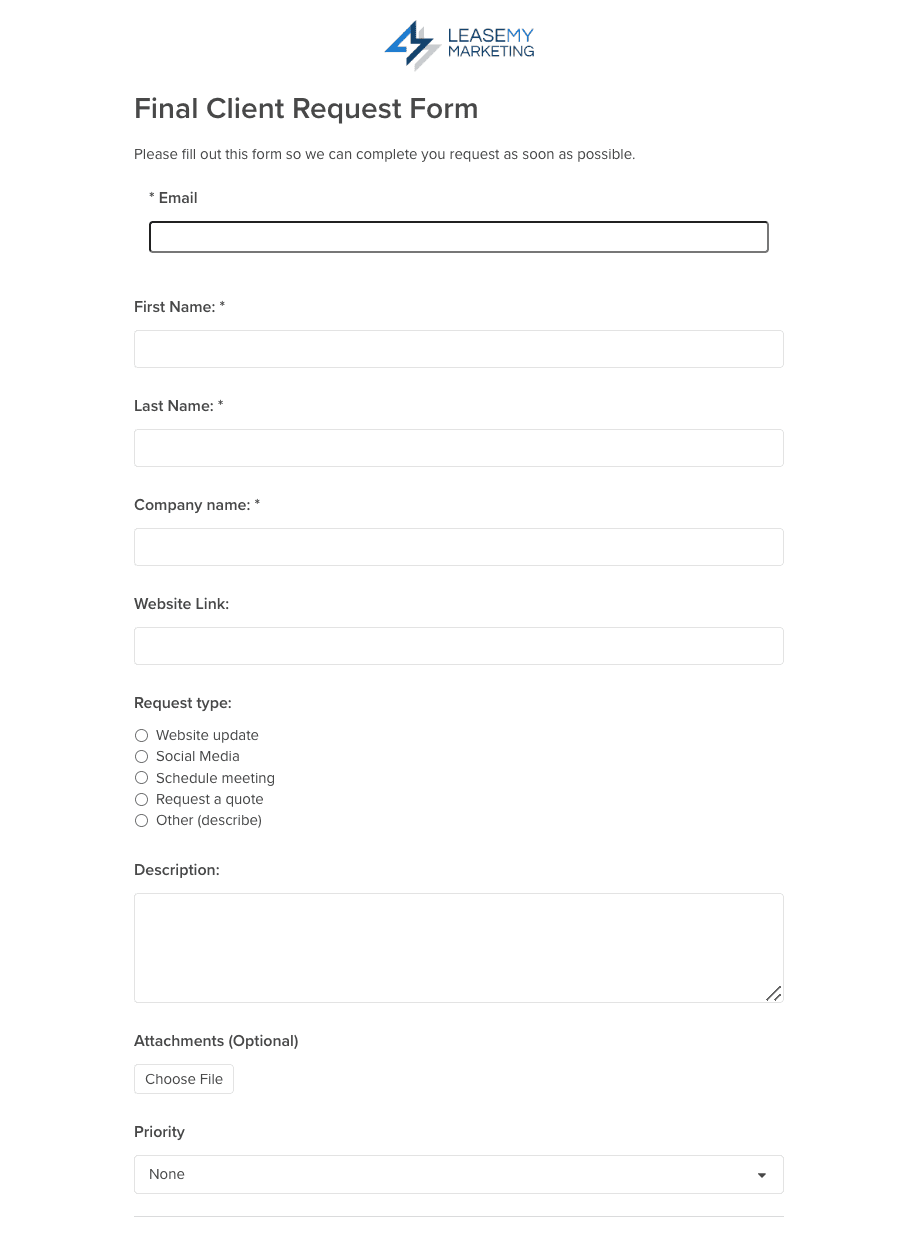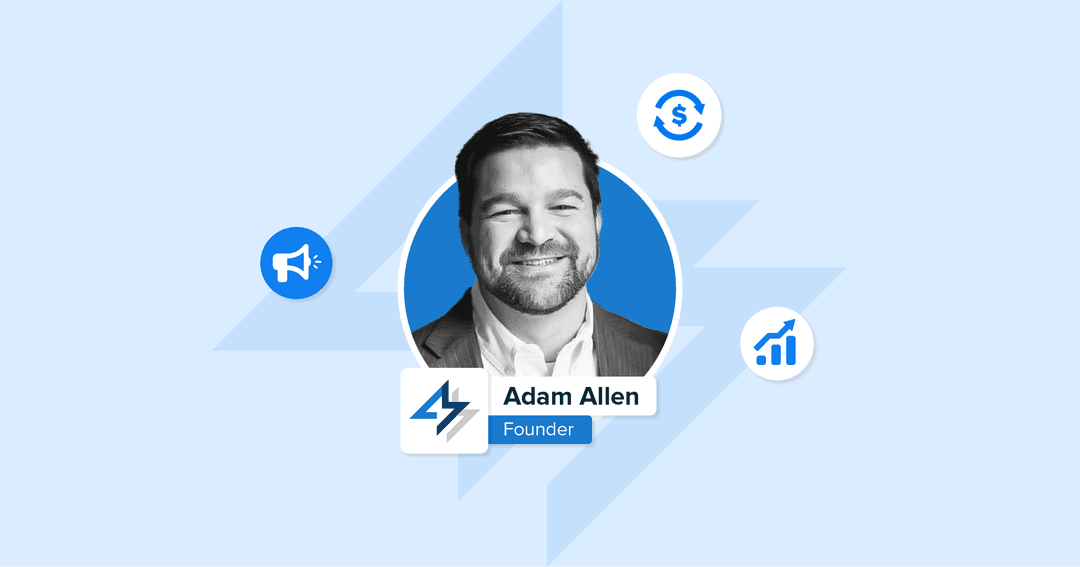Table of Contents
Adam Allen founded his digital marketing agency, LeaseMyMarketing, in 2015 with one goal in mind: creating a sustainable business model destined for growth.
Allen’s experience working with large-scale businesses from the marketing agency he used to work for gave him many skills–from technical SEO services to building websites to managing client expectations and their pain points.
“I always knew I wanted to have my own company, but I never really put much thought into how I would create a scalable company,” Allen admits.
When his wife started her own non-profit business, Allen had an ‘aha moment’ that led him to his entrepreneurial journey. He not only helped her business gain traction on the SERPs, but slowly started picking up other small business clients in Pennsylvania.
The referrals kept coming in and his client base grew steadily until he eventually quit his 9-5 job in the online education space at Pennslyvania State University and focus solely on his agency.
“Being able to work on my business full time really rocketed our sales. We went from managing a handful of accounts to managing over 50 different client websites,” Allen shares.
And his initial work in the early days of his agency helped identify a key problem that he knew he could fix.
“A lot of small businesses don’t have access to their marketing data, let alone understand it or know how to make an informed marketing decision,” he says. “We take the same data-driven approach that makes large corporations so successful and apply it to our regional and national clientele to create meaningful marketing impact.”
Increasing Agency Valuation
Allen recognized that an agency with a recurring revenue model is generally more valuable and more attractive to investors and consumers.
“I started researching recurring income models,” Allen shares. “Not only are they more stable from an income perspective but also valued at a higher multiple if I decide to go in a different direction one day.”
Because they offer website maintenance services for clients with varying budgets and portfolio sizes, his agency leaned into developing recurring revenue models rather than one-time website projects.
“I didn’t want my team to always be tracking down the next sale every month and living off of what’s coming in the door,” Allen says. “I not only needed a recurring revenue stream but also automated, efficient internal processes in place to scale.”
As platforms that have a recurring revenue stream, like Netflix, Disney+, Crave, etc., remain popular, it’s obvious that subscription-based models are successful. In fact, 75% of business leaders say subscription business models are key to business growth.
In a one-time project-based revenue model, revenue is generated based on the success of your agency’s deliverables. Relying on project revenue often makes it more difficult to scale due to the sporadic income and resources to maintain relationships.
Although marketing agencies often need more time and capital to implement recurring revenue business models, the long-term returns are worth the investment. The goal is to create long-term service contracts that include relatively non-labor-intensive tasks that help your agency scale over time.
Ongoing Maintenance As a Client-Retention Strategy
Allen says it’s crucial to remove any potential barriers to get a client to work with your agency in the first place. Then you can focus on building a model that keeps them coming back for more of your services.
When you drop a large price tag in front of a client, it’s unlikely they’ll respond how you want them to.
Consider this scenario:
The number of people who walk into a car dealership with cash in hand to purchase a vehicle outright is slim. However, with the option of leasing a vehicle, that barrier is easier to overcome for the salesperson and the customer.
“Clients often delay spending $5,000 or $10,000 or whatever the price may be to build a new website because that’s a big hit up front,” Allen says. “So if you can remove those barriers and instead turn it into a cash flow problem that affects their business, it piques their interest."
For example, if the client’s business isn’t getting enough leads coming in, this directly affects their cash flow. Allen and his team work with the client to deliver various strategic solutions, such as a PPC campaign mixed with a lead-gen form on their website.
Similarly, if another client is losing potential customers because of a mismanaged appointment booking system, it also creates cash flow problems that affect their business’ bottom line.
“We had an eCommerce client that had an email marketing base of about 6,000 people in their database that they weren’t ever speaking to,” says Allen. “We implemented an email marketing strategy along with a website revamp and increased their sales by 60% and it continues to grow with one of our monthly maintenance plans.”
By turning his clients’ business problems into opportunities for his agency, Allen gains their trust and long-term business with reasonable solutions.
The project-based website method creates unnecessary cash flow constraints on the client’s business. It also creates a scenario where updating their website becomes more challenging and more costly, resulting in poorly kept websites over time.
–Adam Allen, Founder of LeaseMyMarketing
Instead of asking for a large sum of money to build a website and then closing the account when the job is complete, Allen created a monthly fee that his clients could budget for and manage more easily. They package services like development, website analytics, SEO, and a combination of ongoing maintenance to help business owners preserve their online presence.
“I communicate with my clients that our monthly plans have multiple distinct advantages over project-based pricing,” Allen explains. “These include reduced pressure on cash flow, dedicated website resources, and ongoing SEO support, among others.”
But it’s not just about affordability. Ongoing maintenance equates to ongoing growth.
“If you’re not managing and doing the upkeep of a website over time, it’s going to deteriorate,” says Allen. “Building a holistic plan with our clients means we’re able to increase rankings on both a local and national level which leads to higher rankings, more traffic, and more leads for them.”
When explaining that the investment is worth it to his clients in the long run versus a one-time fee, Allen compares his maintenance services to his own physical health.
I start with the concept of a website being like any organic creature. I’m very self-loathing so I compare the website process to myself. If I stopped maintaining myself over time, what’s going to happen? I’m going to deteriorate my body, right? So that’s one of the main reasons why we offer ongoing services–to take care of their website health long-term.
–Adam Allen, Founder of LeaseMyMarketing
But this kind of maintenance parallel can be drawn with almost every personal or business expense, including cars, real estate, and more.
Delivering Value by Improving the Client’s Bottom Line
But Allen didn’t choose this recurring revenue model completely based on his own business interests. He says it’s also in his clients’ best interests.
“Because websites need ongoing maintenance, this is a challenge I see many small business owners having,” he explains.
He would see business owners needing something updated on their website and paying someone every time because they didn’t have the knowledge or expertise to do it themselves.
“It would prohibit business owners from making the necessary website updates, so I looked at creating a sustainable management experience for my clients that saves them money in the long run,” Allen says.
Google is constantly updating its algorithm, so a static website can become stale very quickly. In fact, it’s estimated that Google changes its search algorithm approximately 500 to 600 times each year. Although most of those changes don’t significantly change the SEO landscape, some updates are important and affect the way SEO should be approached for any given client’s website.
Because Allen and his team are dedicated to helping their clients stay ahead of algorithm updates, it’s helped contribute to building trusting, long-lasting relationships.
“By having the client sign on for recurring management services, we get to know them better, provide better recommendations, and an overall better experience for the client,” he adds.
Allen says he has run into the issue of clients not being able to wrap their heads around paying for something as long as they’re in business. But explaining the value and the ‘why’ it matters is what makes all the difference.
“When you think about it, your website should be creating business for you, right? So it should be a marketing and sales tool,” he explains. “We pay hundreds of dollars every month for the cost of doing business like a cell phone. Whereas your website, if it’s done right with good SEO, should be bringing in business.”
“We had a client who wanted to cut their services in half but we were able to go into the analytics reporting and show them, ‘You’re trending up and up and up and if you pull back your budget for x,y,z reasons, your phone calls will drop, your Google listing activity will drop, and your website activity will drop,’” Allen says. “So we were able to show the direct impact of pulling back those resources and the client immediately said, ‘No, no, we can’t. We need to get these things back on.’”
Allen and his team make a real connection with their clients by going beyond the data points and communicating how it affects their business’ bottom line.
Allen’s recurring business model includes other incentives for their long-term clients, like a complimentary redesign service to keep their clients’ websites fresh.
“It took a bit of tweaking and iteration to get this model right,” Allen admits. “And I had to have the courage to turn away those one-time-paying leads because they’re not who our ideal clients are.”
Read More: How to Define Your Ideal Client
Using Marketing Automation Tools To Scale
When Allen first started his agency, he admits that a lot of his processes were very manual–something which would hold him back from growing his agency.
“We looked at our daily repetitive tasks and thought about how we can make it more efficient with automation,” says Allen.
Implementing marketing automation tools streamlined their client billing process, their entire outbound client communications efforts, and more.
For example, if a potential client fills out a form from their GBP listing, the information automatically populates in their project management system and is assigned to the person responsible for completing the task. An email is also sent to the client informing them that their request is being processed.
“If our existing clients want to make an update to their website after we’ve completed their build, we also send them an automated email with a link that leads them to a form,” Allen explains. “It’s helped us save so much time with client communication.”

Although the majority of their clients aren’t tech-savvy, Allen says the automation has been received well.
“We hand deliver the leads our clients get from their lead gen campaigns by using Zapier and our marketing automation software to text or email that lead to them,” he says.
Allen also recognized that automation has many additional benefits–specifically when it comes to client acquisition.
“We always tell our potential clients that we have this online dashboard that they can go into in real time where they can see the SEO results we’re delivering,” Allen smiles.

With the AgencyAnalytics reporting capabilities, Allen and his team display the success of the marketing efforts they undertake for their clients.
“We can show them where all of their leads are coming from,” explains Allen. “We can say, ‘This month you got five phone calls, five leads from Facebook, and five leads off your website. That’s 15 leads in total.’ This shows our value to our clients while also being a huge time-saver for us.”
Creating a marketing dashboard has not only helped them acquire clients and foster ongoing transparent communication but also retain clients who contemplated cutting back services with LeaseMyMarketing. Once Allen’s team has a complete picture of their lead generation volume, they turn their raw lead numbers into a key performance indicator (KPI) like cost per lead (CPL).
“If, for example, a client was paying $300 for our website services and we were able to record 15 leads for the month, we can easily show our clients how their marketing efforts are generating leads for as little as $20 per lead,” Allen explains.

“We love using tools like AgencyAnalytics to show the impact of our work and not just by saying, ‘Oh, your traffic is down,’” Allen says. “I now use AgencyAnalytics in multiple stages of my business, including prospecting, pitching, launching websites, and of course, as a client retention tool."
We perform an SEO audit on every one of our prospects and incorporate the results into each one of our pitch decks. We weren’t looking for this feature in a reporting tool but it made a huge impact on our ability to win business.
–Adam Allen, Founder of LeaseMyMarketing
Long-Term Client Relationships for ROI
Allen’s service model demonstrates why keeping a smaller number of options is often better than giving potential clients too many choices–what’s known as the Paradox of Choice. The more options you give them, the more difficult it is for them to decide.
“We’re not just maintaining an SEO score, but also doing work like link building, blog posting, and more,” he says.
And their clients appreciate the flexibility in their service offerings as well as recommendations that help them make more informed business decisions.
“A client inquired about organic social media, which we do for some of our clients, but we informed them that they shouldn’t be spending their money there because it would be a waste of their money and resources,” Allen says. “I wanted to do right by the client.”
One client in particular that LeaseMyMarketing had success with was a medical practice that went from a $0 valuation to $1 million in just one year of being in business.
“We asked what their revenue goals were and then reverse-engineered what strategies they would need and what they would need to spend to achieve their goal,” says Allen.
They’re currently still a client of LeaseMyMarketing and signed up for a recurring website maintenance plan.
“This is just one example that demonstrates an exclusive, ongoing client relationship delivers a strong return on investment in the long run,” Allen smiles. “It’s been really exciting to grow with them year after year.”
Read More: The Benefits of SEO: What To Tell Clients About Their ROI and Beyond
Focusing on Sustainable Growth
Looking back, when Allen started his agency, he wishes he gave himself some advice on showcasing his agency’s value sooner:
Figure out what people are willing to pay for and then get them results. You have to show people why they should invest with you.
–Adam Allen, CEO, LeaseMyMarketing
After all, showing how your agency solves a pain point for a client and removing any barriers to entry, sets you apart from competitors in your industry. This is something that many agencies fail to do effectively as they focus specifically on the services they offer or get wrapped up in their client’s data.
This can align with the concept of not focusing on your products but focusing on how you–as an agency–can solve their problems.
The most successful businesses understand that communicating their value goes way beyond that.
Allen’s goal for the next year is to double their sales as well as refine their internal processes.
“I set out to create a company that would be highly scalable. So to stay focussed on that goal, we’re currently looking at operational efficiencies,” says Allen. “We want to build up those processes so we can intake new clients without any issues whatsoever.” “AgencyAnalytics has played a critical role in our success, and we have integrated it into nearly every facet of our client lifecycle. It is not just a client reporting tool. If client reporting is the only thing you are using it for, then you are missing out and not fully leveraging the capabilities of the platform. I can’t imagine running an agency without AgencyAnalytics.”

Written by
Richelle Peace is a writer with a degree in Journalism who focuses on web content, blog posts, and social media. She enjoys learning about different topics and sharing that knowledge with others. When she isn’t writing, Richelle spends time teaching yoga, where she combines mindfulness, movement, and her passion for wellness.
Read more posts by Richelle PeaceSee how 7,000+ marketing agencies help clients win
Free 14-day trial. No credit card required.






